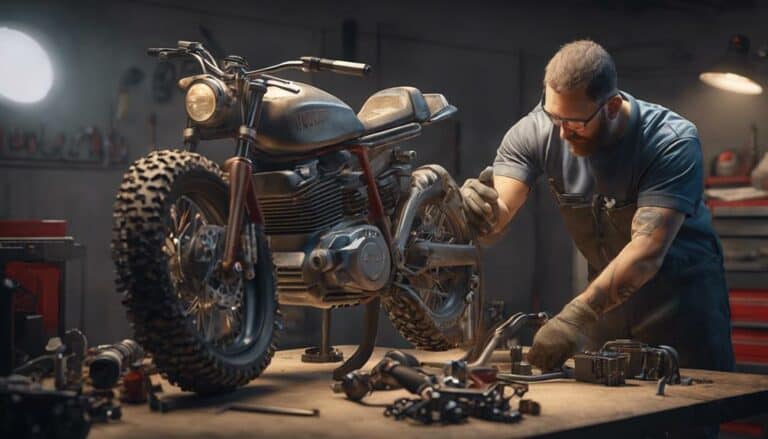To maintain peak performance, tune your dirt bike engine every 20-30 riding hours. This guarantees top efficiency and avoids performance drops. Not tuning may lower overall performance. Factors like bike use and engine needs influence tuning frequency. Signs you need tuning include odd noises, starting issues, and poor fuel economy. Regular maintenance boosts performance, extends engine life, and avoids costly repairs. Consistent engine care is key for peak dirt bike performance. Peak tuning keeps your engine running smoothly and efficiently.
Key Takeaways
- Tune dirt bike engines every 20-30 hours.
- Regular tuning maintains peak performance.
- Factors like usage and engine needs influence tuning frequency.
- Signs include odd noises, starting issues, and poor fuel economy.
- Consistent maintenance boosts performance and longevity.
Recommended Frequency for Dirt Bike Engine Tuning
When maintaining your dirt bike engine for peak performance, it's essential to stick to a regular tuning schedule, typically recommended every 20-30 hours of riding. This frequency guarantees that critical components like the air filter are clean, allowing for ideal airflow into the engine.
A clean air filter is vital for maintaining top-end performance and fuel efficiency. Neglecting to tune your engine within the recommended intervals can lead to a decrease in overall performance, affecting the running condition of your bike.
Importance of Regular Engine Tune-Ups
Regular engine tune-ups are essential for maximizing the performance and longevity of dirt bike engines. Here are four reasons why regular engine tune-ups are important for peak performance:
- Prevention of Major Issues: Regular tune-ups help identify and address potential problems before they escalate, ensuring a smoother running engine.
- Maintenance of Peak Performance: By conducting tune-ups, you can fine-tune engine components to operate at their best, enhancing overall performance.
- Extended Longevity: Proper maintenance tasks during tune-ups can greatly extend the lifespan of your dirt bike engine, saving you from costly repairs or replacements.
- Protection of Engine Components: Ignoring tune-ups can lead to decreased performance, reduced fuel efficiency, and potential damage to crucial engine parts. Regular maintenance helps safeguard these components, ensuring they function optimally.
In essence, adhering to a routine schedule for engine tune-ups is essential for keeping your dirt bike performing at its best while prolonging its lifespan.
Factors Affecting Tuning Frequency
To optimize the performance of your dirt bike engine, the tuning frequency must be determined by factors such as bike usage, type, and specific engine requirements. Factors like the compression ratio, air/fuel ratio, exhaust system, tire pressure, clean air, and overall maintenance play an important role in how often your dirt bike engine needs tuning. Regular tuning guarantees that your engine operates at its best, delivering better performance, fuel efficiency, and reliability. Below is a table highlighting how these factors can impact the tuning frequency of your dirt bike engine:
| Factor | Influence on Tuning Frequency |
|---|---|
| Compression Ratio | Higher ratio may require more frequent tuning |
| Air/Fuel Ratio | Imbalance can lead to more frequent tuning |
| Exhaust System | Efficiency affects tuning needs |
| Tire Pressure | Incorrect pressure can impact engine performance |
| Clean Air | Dirty air filters may necessitate more frequent tuning |
| Maintenance | Regular maintenance can extend time between tune-ups |
Considering these factors can help you determine how often your dirt bike engine needs tuning to ensure top-notch performance.
Signs That Your Dirt Bike Engine Needs Tuning
If you notice decreased power output or acceleration on your dirt bike, it could be an indication that tuning is needed for the engine. To keep your bike's performance at its best, it's important to pay attention to the signs that suggest your engine requires tuning.
Here are four key indicators that your dirt bike engine may need attention:
- Unusual Engine Noises or Vibrations: Any strange sounds or vibrations coming from the engine could signal underlying issues that would be best suited for a tune-up.
- Difficulty Starting or Frequent Stalling: If you find it hard to start the engine or it stalls frequently, it might be time to perform a tune-up to address these problems.
- Poor Fuel Economy: Increased fuel consumption or poor fuel economy can be a sign that your engine needs tuning to optimize performance.
- Rough Running or Hesitation: If your bike runs rough, sputters, or hesitates during acceleration, cleaning or replacing engine components during a tune-up may be necessary to keep it running smoothly.
Benefits of Consistent Engine Maintenance
Maintaining your dirt bike engine consistently is crucial for optimizing its performance and extending its longevity. Regular engine upkeep not only boosts the bike's performance but also contributes to its reliability. By adhering to a proper tuning schedule, you can prevent unexpected breakdowns and costly repairs, enhancing your riding experience and reducing worry. Check out the table below to see the advantages of regular engine maintenance:
| Advantages of Regular Engine Maintenance |
|---|
| Boosts performance |
| Enhances fuel efficiency |
| Prolongs engine longevity |
| Guarantees dependable bike performance |
| Averts expensive repairs |
Conclusion
To summarize, it's essential to fine-tune your dirt bike engine regularly to guarantee peak performance. By adhering to the recommended frequency for engine tuning, you can uphold the longevity and efficiency of your bike.
Neglecting signs that your engine requires tuning can result in expensive repairs and reduced performance. Keep up with your engine maintenance to experience a smoother ride and avoid any unforeseen breakdowns.
Remember, a well-adjusted engine is the key to unleashing top performance on the trails.

